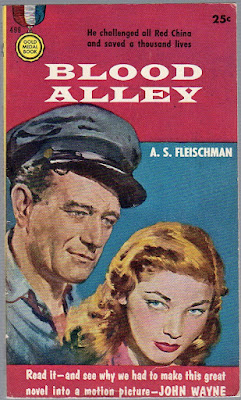This is the second issue of THRILLING MYSTERY, launched by
the Thrilling Group to compete with the success of Popular Publications’
leading Weird Menace pulp DIME MYSTERY. I don’t know who did the cover, but
it’s plenty garish and eye-catching. An e-book reprint of this pulp is
available from Radio Archives, so being both time- and attention
span-challenged, I read it recently.
Wyatt Blassingame was one of the top Weird Menace authors over at Popular, so
it’s no surprise to find him leading off this issue with a novelette called
“The Flame Demon”. I’ve liked everything I’ve read by Blassingame, but
unfortunately, this yarn about a villain calling himself the God of Fire comes
across to me as pretty uninspired. There are some nice action scenes—lots of
big fires, and the protagonist finds himself in a really harrowing position—but
Blassingame seems to have phoned in the muddled plot, which requires quite a
bit of unconvincing exposition in the final pages to explain. I don’t have any way
of knowing, of course, but I suspect that Rogers Terrill at Popular rejected
this story and Harvey Burns, the editor at THRILLING MYSTERY, snapped it up
because of Blassingame’s name recognition in the genre.
“Voice From Hell”, a short story by Jack D’Arcy (really D.L. Champion, creator
of the Phantom Detective), is a Poe-like tale with a clever twist to it about a
murderer tormented by his crime. It’s a slight but enjoyable story and an
improvement over Blassingame’s novelette.
This issue really begins to pick up steam with “Ghouls of the Green Web”, a
novelette from the dependable G.T. Fleming-Roberts. It’s set in a small Kansas
city during the Dust Bowl, one of the few pulp stories I’ve read to use that bit
of real-life history in its plot. Fleming-Roberts does a really nice job with
it, too. The writing is excellent. Fleming-Roberts’ prose can be lurid, over
the top, and genuinely creepy when it needs to be, and then turn around and
achieve a terse, hardboiled, poetic effect. The menace seems a bit more
realistic than some, as well. I really enjoyed this one.
I don’t know anything about James Duncan, author of the novelette “Blood in the
Night” except that his real name was Arthur Pincus and that he wrote dozens of
mystery, detective, and Weird Menace stories for a variety of pulps. His story
in this issue is a bit of a kitchen-sink tale, with a witch’s curse, murders
that appear to have been committed by a vampire, and an old house full of heirs
to a fortune who benefit by knocking each other off, a set-up reminiscent of an
Agatha Christie novel, plus a master detective who is, at least, nothing like
Hercule Poirot. Duncan pulls it all together and makes it work in a reasonably
entertaining fashion.
Likewise, I know very little about Saul W. Paul, author of the short story
“Forest of Fear”. That appears to have been his real name, and he sold about a
dozen stories in the Thirties, mostly to the Spicy pulps. This story, about a
honeymooning young couple who encounter a deadly menace in the woods, is only
borderline Weird Menace and has nothing even apparently supernatural about it,
but it does strike a few nicely creepy notes.
Arthur J. Burks was a million-words-a-year man, so I’m surprised I haven’t read
more by him, only a few stories here and there. His novelette in this issue, “Demons
in the Dust”, is another Dust Bowl yarn, but Burks carries the situation so far
that this story reads more like post-apocalyptic science fiction than Weird
Menace. And as post-apocalyptic SF, it’s not bad, although the plot—the protagonist
and his newlywed wife try to escape from a particularly bad dust storm—is a
little thin. But there’s lots of action and it’s well-written, making for a
bleak but satisfying tale.
H.M. Appel is another author I’m not familiar with, except for seeing on the
Fictionmags Index that he wrote several dozen stories for various Weird Menace
and detective pulps. His short story “Hooks of Death” isn’t really Weird
Menace, either, despite being fairly grisly in places. It’s about a young
highway patrolman’s pursuit of a serial killer stalking a particular stretch of
road. The prose has plenty of momentum and the hero’s background furnishes a
nice twist.
Jack Williamson isn’t a name I expected to encounter in the Table of Contents
in a Weird Menace pulp, but in addition to being one of the giants of science
fiction, Williamson also wrote a considerable amount of fantasy and horror, so
it’s not that much of a stretch. His novelette “Grey Arms of Death” is about
some very Cthulhu-like creatures from the depths of the Atlantic Ocean stalking
some deep-sea explorers and invading a lonely cliffside mansion. I don’t know
if Williamson ever read Lovecraft, but based on this story I feel like there’s
a good chance he did. This is pure Weird Menace, and Williamson, already a very
seasoned pro in 1935, throws himself into the breakneck, lurid prose with great
gusto. This is a fast-moving and very entertaining story, probably my favorite
in the whole issue.
Overall, this issue of THRILLING MYSTERY is a satisfying read, even though some
of the stories don’t fit the Weird Menace genre that well. I have no way of
knowing, but since it was only the second issue, I suspect that the stories by
Duncan, Paul, and Appel were intended originally for POPULAR DETECTIVE or
possibly as back-ups in THE PHANTOM DETECTIVE and were pulled out of inventory
to go in THRILLING MYSTERY. But that’s pure speculation on my part.



.jpg)










.jpg)









